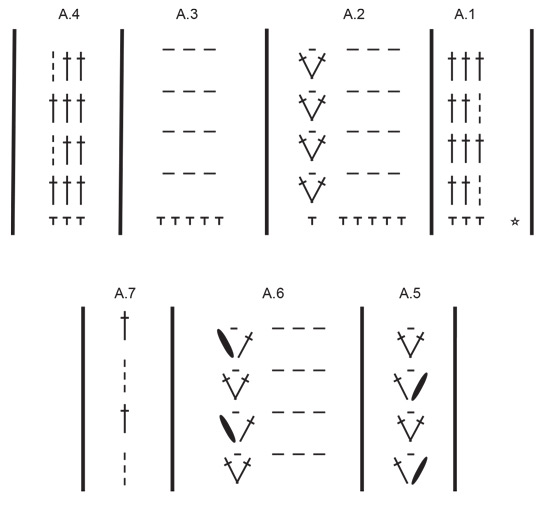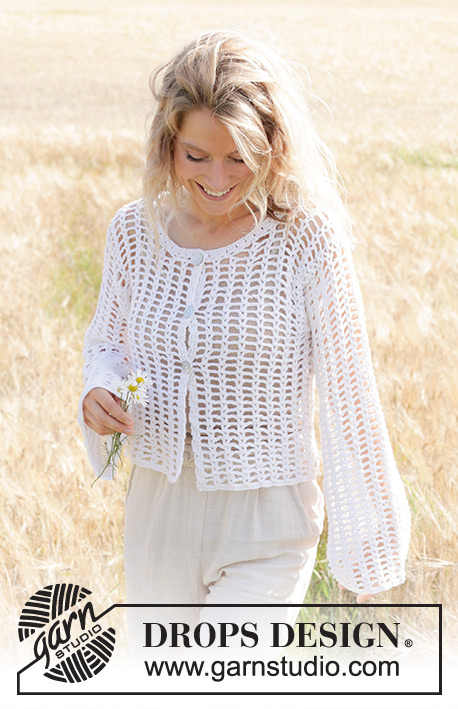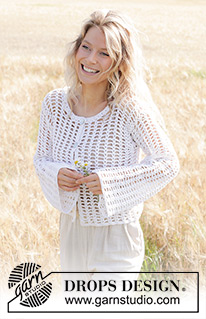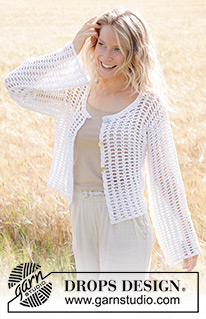Comments / Questions (15)
![]() Anna wrote:
Anna wrote:
Hej, Sista raden för ärmar står det att "Virka RAD 2 och 3 fram och tillbaka så här tills ärmen mäter 55-53-54-52-53-51 cm. Klipp och fäst tråden." Är det avsiktligt att strl S ska ha längst ärmar och att XXL kortast men också att M och XL ska ha samma längd? Förstår inte logiken helt! Jag virkar i storlek M
25.02.2025 - 09:51DROPS Design answered:
Hej Anna, ja det stemmer, jo bredere skuldervidde jo kortere ærmer, se også måleskitsen nederst i opskriften :)
05.03.2025 - 14:29
![]() Anna wrote:
Anna wrote:
På bakstycke står det ”virka rad 2 och 2 fram och tillbaka, antar att ni menar 1 och 2? Och sen i nästa stycke HÖGER AXEL BAK står det att man ska virka rad 1 och 3 fram och tillbaka men både de avser rätsida, menar ni 1 och 2? Eller 2 och 3?
28.12.2024 - 14:31DROPS Design answered:
Hei Anna. Er er det blitt feil på den svenske teksten, dette vil vi få rettet asap. Takk for at du gjorde oss oppmerksom på dette. Det riktige skal være, slik du også skriver: BAKSTYCKE: Virka RAD 1 och 2 fram och tillbaka .... HÖGER AXEL BAK: Virka RAD 2 och 3 fram och tillbaka .... mvh DROPS Design
06.01.2025 - 13:02
![]() Anne wrote:
Anne wrote:
Hello there, I’m stuck after the first neckline portion of the pattern. It does say you end up with 25 stitches, but A.8 is only 7 stitches wide.. I don’t understand where to continue for the shoulder part. Thanks in advance!
01.09.2024 - 20:26DROPS Design answered:
Dear Anne, you continue working as said before, ie from WS: A.6, then A.2 2 times then A.8 (from RS: A.8 A.2 2 times and A.6), when A.8 is done, there are 7 sts left in A.8 + 6 sts x 2 in A.2 + 6 sts in A.6 = 25 sts. just work now A.7 instead of A.8 towards neck, this means you will have now 3 repeats of A.2 between A.7 and A.6. . Happy crocheting!
02.09.2024 - 09:18
![]() Marije wrote:
Marije wrote:
Ik ben net begonnen met het haken en loop meteen vast bij A1. Wat wordt bedoeld met het eerste symbool waar drie streepjes boven elkaar staan?
28.07.2024 - 11:48DROPS Design answered:
Dag Marije,
Deze 3 streepjes zijn 3 lossen welke je als vervanging van 1 stokje haakt.
31.07.2024 - 09:49
![]() Wil Kerkmeer wrote:
Wil Kerkmeer wrote:
Klaar! Wat een ontzettend leuk patroon! Lekker opschieten en geweldig om te maken!|
25.07.2024 - 16:17
![]() Wil Kerkmeer wrote:
Wil Kerkmeer wrote:
Dit zou betekenen dat mt S ook te ruim berekend zou zijn. Moeilijk verhaal, zou het een optie kunnen zijn om xl te haken met haaknaald 3 ?
14.07.2024 - 13:49
![]() Wil Kerkmeer wrote:
Wil Kerkmeer wrote:
Ik ben enthousiast begonnen met het haken van mt L en ik vind het wat aan de krappe kant. Uiteindelijk valt het me op in het patroon dat de maatgeving voor 95% hetzelfde is als voor mt M.?😳graag zsm jullie feedback. Vrgr
11.07.2024 - 09:36DROPS Design answered:
Dag Wil,
Je hebt inderdaad gelijk dat maat L voor een groot deel overeenkomt met maat M. Ik denk dat dit komt door de afronding van de steken in het patroon. Als ik de maten naast vergelijkbare patronen leg, komen de maten wel overeen met maat L en lijkt het eerder zo dat maat M naar maat L getrokken is.
14.07.2024 - 12:00
![]() Angeline Poldervaart wrote:
Angeline Poldervaart wrote:
Dank voor antwoord op mijn vraag over kop mouw. Begrijp ik het goed dat ik toer niet sluit na toevoegen stokje?
05.06.2024 - 20:50DROPS Design answered:
Dag Angeline,
Dat klopt inderdaad, je sluit de toer niet meer vanaf dat punt. Daardoor is de naad midden onder de mouw een stukje open aan de bovenkant.
12.06.2024 - 16:57
![]() Laura wrote:
Laura wrote:
Are the shoulder and arm seams done with right or wrong sides together?
04.06.2024 - 01:52DROPS Design answered:
Dear Laura, yes, you should crochet those pieces with their wrong sides together. Happy Crafting!
04.06.2024 - 02:53
![]() Angeline Poldervaart wrote:
Angeline Poldervaart wrote:
Beste, ik kom er niet uit bij de mouw. Wanneer mouw 50 cm meet,met de laatste toer ...... tm zodat er 2 stokjes (1stokje + 3 lossen) midden onder de mouw zitten, keer het werk. Allerlei variaties uitgeprobeerd op deze instructie, maar krijg een rare uitstulping. Ik begrijp het niet.
02.06.2024 - 21:50DROPS Design answered:
Dag Angeline,
Je hebt aan het begin van de toer 3 lossen gehaakt om het eerste stokje te vervangen. Aan het einde van diezelfde toer haak je een stokje in de steek waaruit de 3 lossen komen. Dan keer je het werk en haak je heen en weer. Er komt een soort inkeping die aan de panden genaaid wordt. Zie de tekening onderaan. (b bij de mouw en B bij de panden.).
03.06.2024 - 11:42
Moon Lace Cardigan#moonlacecardigan |
||||||||||||||||||||||
 |
 |
|||||||||||||||||||||
Crocheted jacket in DROPS Belle. The piece is worked bottom up with lace pattern and wide, sewn-in sleeves. Sizes S - XXXL.
DROPS 249-32 |
||||||||||||||||||||||
|
------------------------------------------------------- EXPLANATIONS FOR THE PATTERN: ------------------------------------------------------- CHAIN STITCH: If you work outermost on the hook the chain stitch will often be too tight; 1 chain stitch should be as long as 1 double/treble crochet is wide. PATTERN: All diagrams show all rows in the pattern, seen from the right side. Remember diagrams are read from left to right when working from the wrong side. See diagrams A.1 to A.9. CROCHET INFORMATION (mid-under sleeves): At the beginning of each round, work 3 chain stitches (equivalent to 1 treble crochet), finish the round with 1 slip stitch in the 3rd chain stitch. When working the sleeves in the round, turn after each round, working alternately from the right and wrong side. ------------------------------------------------------- START THE PIECE HERE: ------------------------------------------------------- JACKET - SHORT OVERVIEW OF THE PIECE: The piece is worked back and forth from mid-front, bottom up as far as the armholes, divided for the front and back pieces and each piece then finished separately, back and forth. The sleeves are worked in the round, bottom up as far as the sleeve cap, which is finished back and forth. The pieces are crocheted together. An edge is worked along the neckline to finish. BODY: Work 186-210-210-234-258-282 CHAIN STITCHES – read description above, with hook size 3.5 mm and DROPS Belle. Turn and work the first row from the wrong side as follows: 1 double crochet in the 2nd chain stitch from the hook, 1 double crochet in every chain stitch = 185-209-209-233-257-281 double crochets. Work PATTERN – read description above, as follows from the right side: A.1 (= band), A.2 29-33-33-37-41-45 times in width, A.3 and finish with A.4 (= band). There are 183-207-207-231-255-279 stitches (29-33-33-37-41-45 treble-crochet groups with 3 chain stitches between each group and 3 treble crochets on each side (mid-front) for the bands. Continue this pattern back and forth. REMEMBER THE CROCHET TENSION! When the piece measures 24-25-25-27-28-28 cm and the next row is from the right side, divide for the front and back pieces as follows. RIGHT FRONT PIECE (when garment is worn): ROW 1 (= right side): Continue A.1, work A.2 a total of 5-6-6-7-7-8 times, A.6, turn = 39-45-45-51-51-57 stitches. ROW 2 (= wrong side): Work A.6, A.2 a total of 5-6-6-7-7-8 times, A.1, turn = 39-45-45-51-51-57 stitches. Repeat ROWS 1 and 2 until the piece measures 34-36-36-38-38-40 cm, with the next row from the wrong side. Now decrease for the neckline. NECKLINE: Start from the wrong side and work as follows: A.6, A.2 1-2-2-3-3-4 times, A.8 (starting at the arrow in the diagram and working from left to right). Continue like this back and forth until A.8 is finished in height and the next row is from the right side = 19-25-25-31-31-37 stitches. Now work the shoulder. SHOULDER: ROW 1 (= right side): Work A.7, A.2 a total of 2-3-3-4-4-5 times, A.6, turn. ROW 2 (= wrong side): Work A.6, A.2 a total of 2-3-3-4-4-5 times, A.7, turn. Repeat ROWS 1 and 2 until the piece measures 42-44-46-48-50-52 cm. Cut and fasten the strand. BACK PIECE: Start from the right side, after the right front piece. Skip 2-2-2-2-4-4 repeats of A.2 and 1 repeat of A.3 (a total of 15-15-15-15-27-27 skipped stitches = armhole), work 1 slip stitch around the chain stitch in the next treble-crochet group then work as follows: ROW 1 (= right side): Work A.5 in the same treble-crochet group, A.2 a total of 11-13-13-15-15-17 times, A.6, turn = 75-87-87-99-99-111 stitches. ROW 2 (= wrong side): Work A.6, A.2 a total of 11-13-13-15-15-17 times, A.5, turn. Repeat ROWS 1 and 2 until the piece measures 39-41-43-45-47-49 cm and the next row is from the right side. Now work the shoulder. RIGHT BACK SHOULDER (when garment is worn): ROW 1 (= right side): Work A.5, A.2 a total of 2-3-3-4-4-5 times, A.3, A.7 in first treble crochet from the next treble-crochet group, turn = 19-25-25-31-31-37 stitches. ROW 2 (= wrong side): Work A.7, A.3, A.2 a total of 2-3-3-4-4-5 times, A.5, turn. ROW 3 (= right side): Work A.5, A.2 a total of 2-3-3-4-4-5 times, A.3, A.7, turn. Repeat ROWS 2 and 3 until the piece measures 42-44-46-48-50-52 cm. Cut and fasten the strand. LEFT BACK SHOULDER (when garment is worn): Skip the rest of the treble-crochet group A.7 was worked in, skip 5 repeats of A.2 and 1 repeat of A.3, skip the first treble crochet and chain stitch in the next treble-crochet group (a total of 37 stitches skipped = back of neck), work 1 slip stitch in the last treble-crochet group, continue as follows: ROW 1 (= right side): Work A.7, A.2 a total of 2-3-3-4-4-5 times, A.6, turn = 19-25-25-31-31-37 stitches. ROW 2 (= wrong side): Work A.6, A.2 a total of 2-3-3-4-4-5 times, A.7, turn. Repeat ROWS 1and 2 until the piece measures 42-44-46-48-50-52 cm. Cut and fasten the strand. LEFT FRONT PIECE (when garment is worn): Start from the right side after the back piece. Skip 2-2-2-2-4-4 repeats of A.1B and 1 repeat of A.1C (a total of 15-15-15-15-27-27 skipped stitches = armhole), work 1 slip stitch around the chain stitch in the next treble-crochet group and continue as follows: ROW 1 (= right side): Work A.5, A.2 a total of 5-6-6-7-7-8 times, A.3, A.4, turn. ROW 2 (= wrong side): Work A.4, A.3, A.2 a total of 5-6-6-7-7-8 times, A.5, turn. Repeat ROWS 1 and 2 until the piece measures 34-36-36-38-38-40 cm, with the next row from the right side. Now decrease for the neckline. NECKLINE: Start from the right side and work as follows: A.5, A.2 2-3-3-4-4-5 times, A.9. Continue back and forth like this until A.9 is finished in height and the next row is from the right side = 19-25-25-31-31-37 stitches. Now work the shoulder. SHOULDER: ROW 1 (= right side): Work A.5, A.2 a total of 2-3-3-4-4-5 times, A.3, A.7, turn. ROW 2 (= wrong side): Work A.7, A.3, A.2 a total of 2-3-3-4-4-5 times, A.5, turn. Repeat ROWS 1 and 2 until the piece measures 42-44-46-48-50-52 cm. Cut and fasten the strand. SLEEVES: Work 70-76-82-82-88-94 chain stitches with hook size 3.5 mm and form them into a ring with 1 slip stitch in the first chain stitch worked. Work in the round as follows: 1 chain stitch (= 1 double crochet), 1 double crochet in each chain stitch, finish with1 slip stitch in the first double crochet = 70-76-82-82-88-94 double crochets. Now work pattern as follows, read CROCHET INFORMATION: Work 3 chain stitches, A.2 11-12-13-13-14-15 times, A.3 and finish with 1 slip stitch in the 3rd chain stitch at the beginning of the round, turn. Continue like this in the round, alternately from the right and wrong side until the sleeve measures 51-49-50-48-46-44 cm, with the last round worked from the right side and, on the last round, working 1 treble crochet in the stitch before the 3 chain stitches at the beginning of the round, so there are 2 treble crochets (1 treble crochet + 3 chain stitches) mid-under sleeve, turn. Now continue back and forth: ROW 1 (= wrong side): Work A.7, A.3, A.2 a total of 11-12-13-13-14-15 times, work 1 treble crochet in the last stitch = 71-77-77-83-89-95 stitches, turn. ROW 2 (= right side): Work A.7, A.2 a total of 11-12-13-13-14-15 times, A.3, A.7, turn. ROW 3 (= wrong side): Work A.7, A.3, A.2 a total of 11-12-13-13-14-15 times, A.7, turn. Repeat ROWS 2 and 3 back and forth until the sleeve measures 55-53-54-52-53-51 cm. Cut and fasten the strand. ASSEMBLY: Crochet the shoulder seams together as follows: 1 double crochet in the outermost stitch (through both layers), 1 chain stitch, 1 double crochet around the chain-space on the front piece, 1 chain stitch, 1 double crochet around the chain-space on the back piece, 1 chain stitch, 1 double crochet around the chain stitch in the treble-crochet group on the front piece, 1 chain stitch, 1 double crochet around the chain stitch in the treble-crochet group on the back piece, continue like this, crocheting alternately on the front and back piece until the shoulder seam is finished. Work the other shoulder seam in the same way. Crochet the sleeve cap to the armhole in the same way (a to A – see sketch). Then crochet together the bottom of the armhole (b to B). NECK: Start from the wrong side and work an edge around the neckline as follows: ROW 1 (= wrong side): Work 1 double crochet in each of the 3 treble crochets mid-front, * work 3 chain stitches, 1 double crochet around the first/next chain-space/row *, work from *-* along the neckline, finish with 3 chain stitches and 1 double crochet in each of the 3 treble crochets mid-front, turn. ROW 2 (= right side): Work 3 chain stitches (replaces the first treble crochet), work 1 treble crochet in each of the next 2 double crochets, work 3 treble crochets around each chain-space, finish with 1 treble crochet in each of the last 3 double crochets. Cut and fasten the strand. ASSEMBLY: Sew the buttons onto the left band – the top button is on the neck, the other 2 with 8-8-8-9-9-9 cm between each one. |
||||||||||||||||||||||
Diagram explanations |
||||||||||||||||||||||
|
||||||||||||||||||||||

|
||||||||||||||||||||||

|
||||||||||||||||||||||

|
||||||||||||||||||||||

|
||||||||||||||||||||||
Have you finished this pattern?Tag your pictures with #dropspattern #moonlacecardigan or submit them to the #dropsfan gallery. Do you need help with this pattern?You'll find 7 tutorial videos, a Comments/Questions area and more by visiting the pattern on garnstudio.com. © 1982-2025 DROPS Design A/S. We reserve all rights. This document, including all its sub-sections, has copyrights. Read more about what you can do with our patterns at the bottom of each pattern on our site. |
||||||||||||||||||||||

























































Post a comment to pattern DROPS 249-32
We would love to hear what you have to say about this pattern!
If you want to leave a question, please make sure you select the correct category in the form below, to speed up the answering process. Required fields are marked *.